If you follow this website, its forum and other forums, you will notice the growing attention drawn to the use of technical cameras in combination with digital backs among landscape and architecture photographers
As you may already know I work for Leaf; Leaf has always been at the forefront of development of high-end digital backs. Since joining Team Phase One a couple of years ago and the release of the Aptus-II 12 and more recently the IQ180, a lot of the team’s focus was on fine-tuning and perfecting the capabilities of these products for those customers who use them on technical cameras in the field, both in terms of image quality but also in terms of functionality.
Leaf has just released a new version of Leaf Capture, which brings a major firmware upgrade to the Aptus-II digital backs with a new GUI (Graphic User Interface).
This new GUI has many new exciting features but I would like to focus on one of them, which in my opinion, marks a breakthrough for those who use their backs on the likes of ALPA, Arca-Swiss, Cambo, Horseman and Sinar cameras in conjunction with wide angle lenses, what some call “pancake” cameras.
In my role as a product manager, I have been lucky to be involved in developing the digital backs from the field side and as such, I use most or all of these cameras and lenses on a regular base, for demonstrations and tests but also for perusing and pushing my own photography.
In early May this year, I was in Berlin for work. I’ve been there several times before but due to ever pressing time constraints, I’ve only ever seen the inside of a taxi, an office or a studio. This time I had a perfect excuse for staying one more day, free of any appointments…I had my Aptus-II 12R, loaded with the new firmware and mounted on an Arca-Swiss Rm2D (insert a plug: thank you Arca-Swiss!!!) with a Schneider-Kreuznach 43mm/f5.6 Digitar lens on view cameras.
Those who use their digital backs (Leaf or others) are mostly familiar with terms such as “Lens Calibration”, “Color Cast”, “LCC” etc. These all relate to the same basic “effect” caused by using a wide angle lens that sits very close to the sensor. In reality this means that your images will often show non-uniform Magenta, Green, Cyan and Yellow color cast across the frame, something that looks like this:
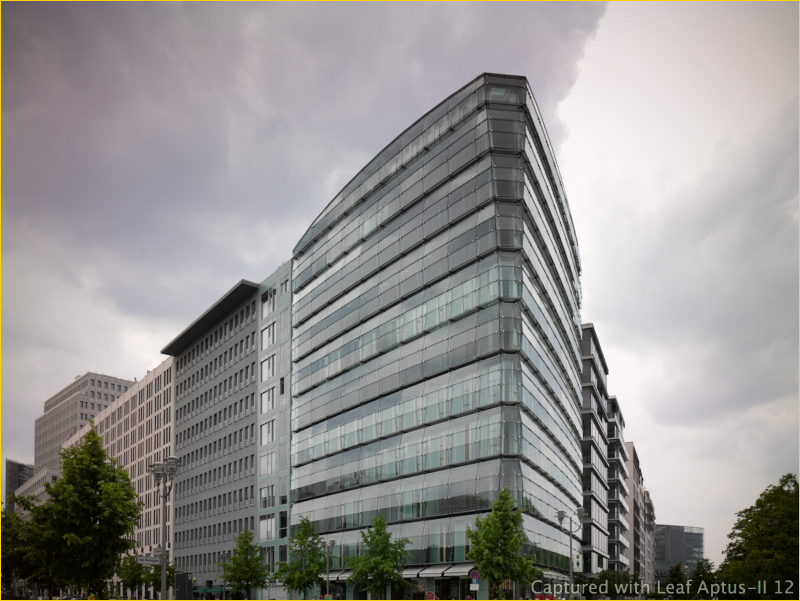
The above image also shows some luminance falloff, caused by shifting the lens (or the back) and getting near the edge of the lens’s image circle.
Until now, you would have to pull out your White plastic diffuser filter, adjust the shutter speed (to allow for another 2 stops of light to come through), take another shot and then later use your choice of software (in my case Leaf Capture or Capture One) to correct for these casts and fall off effects.
Well, now we enter a new era…let me start from the end:
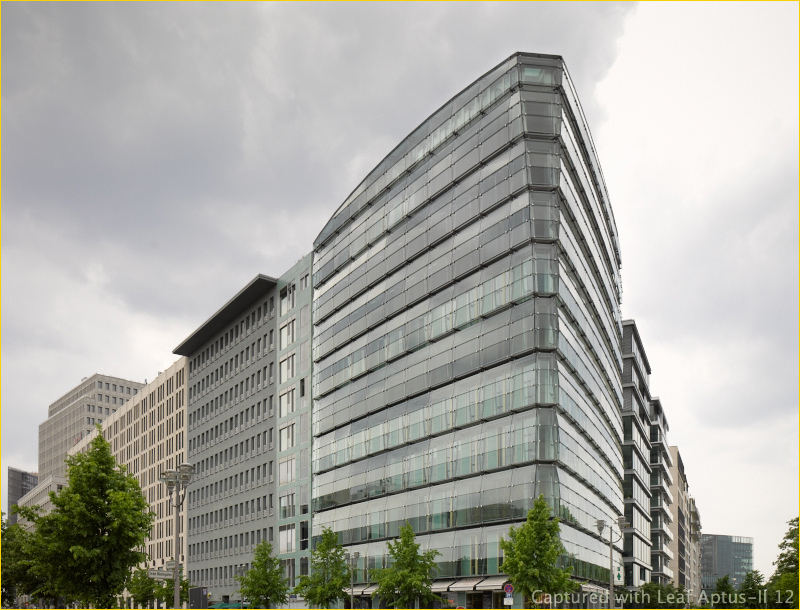
Potsdamer Platz
You will notice that the casts are gone as well as the fall-off/ vignetting and that the image looks a lot cleaner in terms of color and tonality. The news are that this is how it came off the CF card!!!! I did some minor adjustments in Capture One to exposure and saturation but I skipped the LCC process altogether!
So How Does it Work?
After breakfast at the hotel, I mounted the camera on my mini tripod: a 12” one, just strong enough to hold a ball-head and a camera with a digital back on it. It goes into any backpack and is useful for city work with its unique low-level viewpoint.
Shooting tethered to my laptop, I created two sets of calibration shots for f8 and at 5mm rise increments, one set for vertical frames and one for horizontal frames. So a set would look like:
43_f8_H_0
43_f8_H_5
43_f8_H_10
43_f8_H_15
Focal Length _ Aperture _H/V _ rise (in mm)
In Leaf Capture 11.5, there’s a new menu item calledLens Calibration>Save for CF card. This takes the calibration shots and converts them into data files that the back can read and can use on-the-fly to correct for color casts and luminance falloff.
After that, these files are stored in a designated folder on the CF card(s). With a bit of practice this process becomes very easy and in the field, all you have to do is to select a Calibration file before taking a shot at e.g. f/8 and 10mm rise and bob’s your uncle! Of course you can make as many files as you need or like to cover almost any aperture & lens displacement combination. This may take longer although many of the photographers I work with would appreciate a limited choice as it speeds up their work. Leaf has also built some level of tolerance into the algorithm so a change of 1mm or a 1/3 rd of a stop won’t affect the result so much
While making them you can also set the amount of fall off correction; personally I like to keep some vignette especially when there’s a lot of sky in the photo.
The new Graphic User Interface which comes as a part of the new Leaf Capture 11.5 helps make it a lot easier now to navigate through the menus and the “Outdoor” color theme help seeing the LCD outside.
Below are a couple more images from my day in Berlin. The was mostly overcast which for me worked fine with the mood I was looking for:
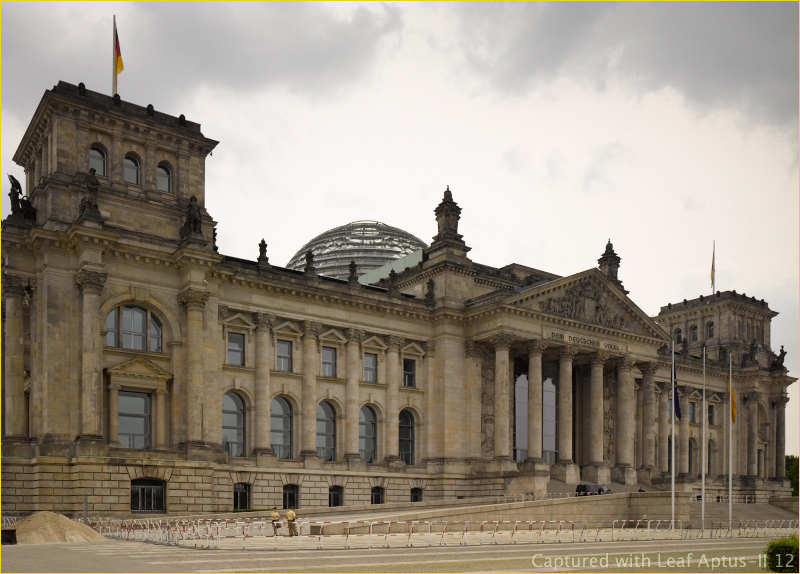
The Reichstag Building
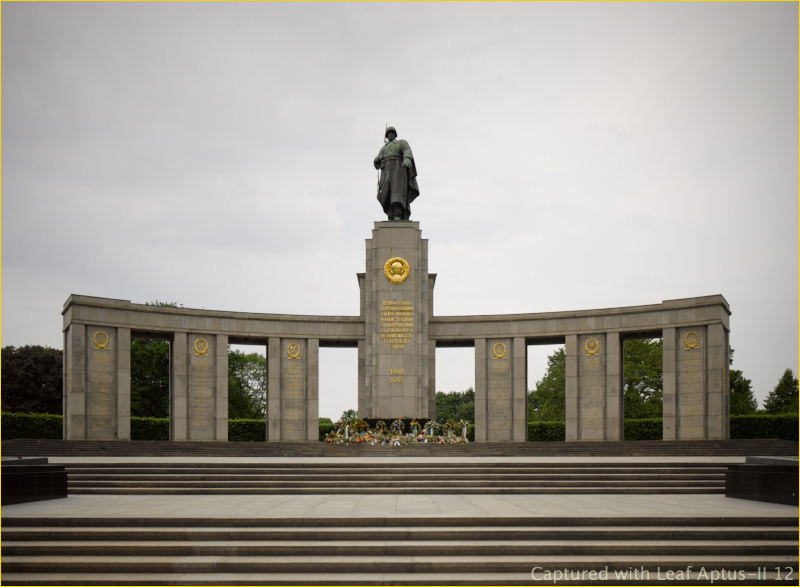
The Soviet Memorial For WWII Soldiers
The beauty in this new feature is twofold.
-
-
In the field, looking at the LCD, the images come up “as they should”. This is particularly important if you have a customer on-site as you do not have to explain why one side of the image looks Green and why the top corners are so dark etc.
- Once back in the studio, or at the hotel or on the plane. You can concentrate on editing and adjusting your images from a creative side without having to go through sorting the images from the calibration/ LCC files and then to go through any correction process. This I think is the strongest point as it lets you do what you do best: Creating images!
-
I would recommend this new software to anyone who uses a technical camera, especially with wide-angle lenses. All you need to do is to download the new software, install it on your Mac and then connect your back and let it upload it.
I would even go as far as suggesting to consider a new Leaf Aptus-II back! It is THAT good!!!
Please feel free to contact me if you have any questions or if you wish to go deeper into the technical details.
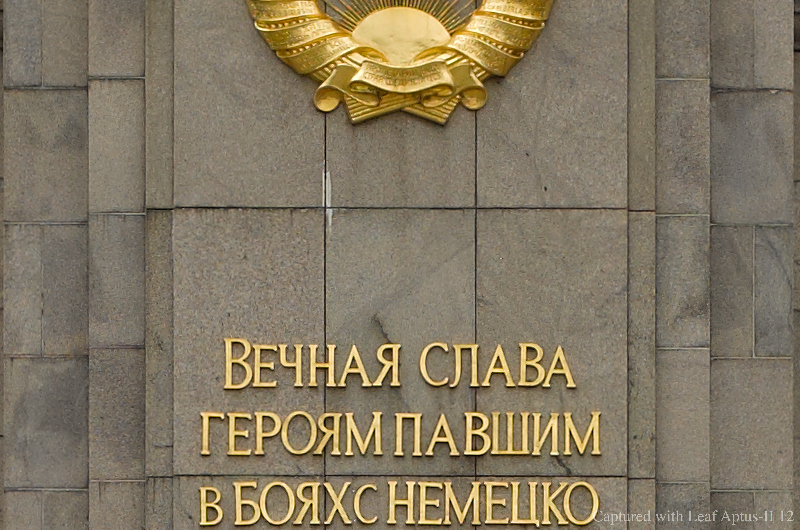
100% Crop
May, 2011
Yair Shahar | Product Manager | Leaf Imaging Ltd.
ysh@leaf-photography.com | m: +44(0)77 8992 8199 | www.leaf-photography.com
Leaf, a Phase One company
You May Also Enjoy...
Video Clips 9
This Page Contains Links to a Few SelectedPreview Video Clips From The Current Issue ofThe Luminous Landscape Video Journal. These low-resolution video clips are in QuickTime
Arca Swiss Rm3d Review
An Unusual Review of an Unusual Camera This is going to be an unusual review of an unusual camera from an unusual company. The Company
